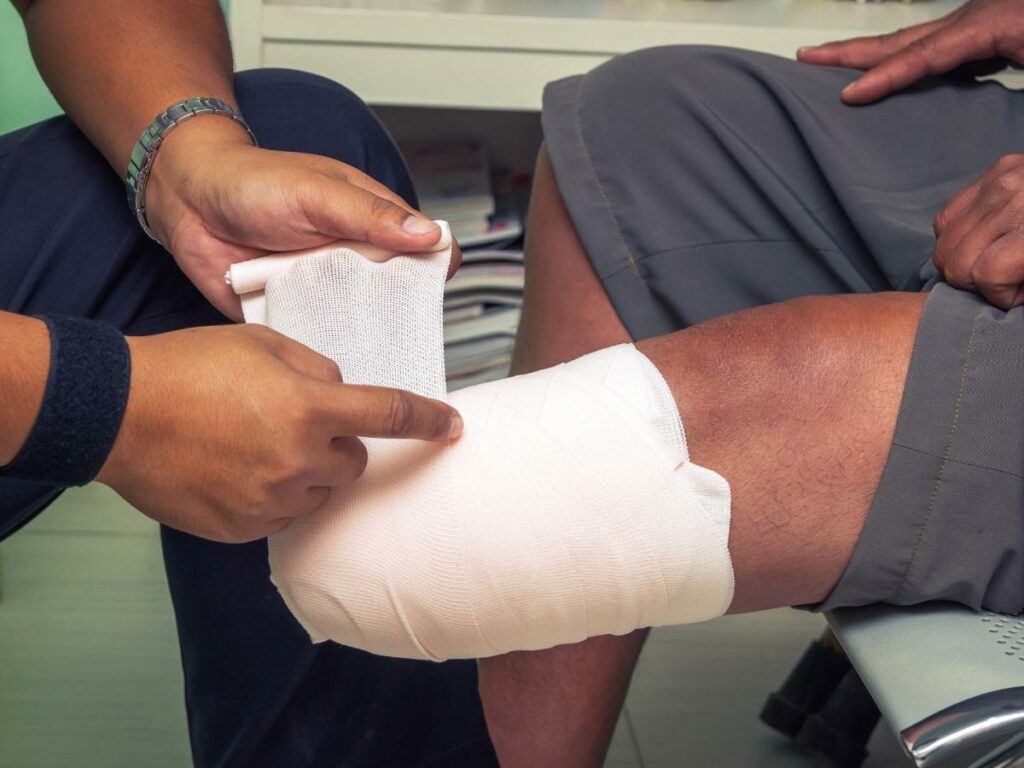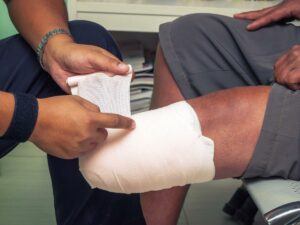Few first aid incidents are more shocking than accidental amputations. Usually occurring very suddenly, the result can be extremely severe and quite horrific. However, it’s important that, if you do witness such an injury, you stay calm, and respond quickly and methodically.
Knowing how to provide first aid for amputations correctly can truly save lives. In this article, we will go through the exact steps you should take and address common myths about providing first aid for severed body parts.
Immediate First Aid Treatment for Amputations
- Call 000 immediately
- Stop the bleeding
- Wash hands
- Lay the injured person down
- Look for visible objects in the wound
- Apply steady pressure
- Wait for professional medical assistance
- Monitor the person’s condition
- Care for the wounded area
See here for in-depth first aid treatment for amputations
Jump to a section in this article:
- Should you put the amputated body part on ice?
- Can an amputated body part be reattached?
- First aid for amputations
Should I put the amputated body part on ice?
Contrary to popular belief, no you should not put amputated body parts directly on ice, as this can damage them. Instead, wrap it in a clean damp cloth, then wrap the part in a waterproof bag or container, and place it into cold water or ice water.
Can an amputated body part be reattached?
In many instances, yes, the amputated part may be able to be successfully reattached. However, this will depend on:
- What has been amputated
- The condition of the amputated part, including how well it has been preserved
- The condition of the amputation site
- The length of time between amputation and replantation
- The overall health of the person
First aid for amputations
Amputation is a broad term that applies to the removal of a part of the body, either surgically or accidentally. Accidental amputations can be complete (fully severed) or partial (cut off, but still attached), and are most often caused by road crashes, and farm and factory machinery incidents. While any part of the body can be amputated, ears, fingers, and toes are most commonly impacted.
In the event of an accidental amputation, it is important to respond quickly and calmly.
Call 000
Regardless of which part of the body is impacted, and if the amputation is complete or partial, you should call an ambulance. If possible, get someone else to make this call while you begin administering first aid.
Stop the bleeding
While the body’s natural defences may mean there is less blood than you would expect, preventing blood loss is still crucial. To do this, you should:
Wash hands
If possible, wash your hands thoroughly with soap and water and wear disposable gloves. If you do not have gloves, cover your hands with clean cloth or plastic bags.
Lay the injured person down
If appropriate, lay the injured person down, elevating the amputation site above their head. Do not attempt to move them if you suspect they have a spinal injury.
Look for visible objects in the wound
If there are any visible objects in the wound, only remove them if it is easy to do so.
Apply steady pressure
Using a clean cloth or gauze, apply steady pressure directly to the wound. If there is an object in the wound that cannot be removed, apply pressure around it. If blood soaks through the material, do not remove it – apply additional cloth or gauze on top of it.
Wait for professional medical assistance
Continue applying consistent pressure, until professional medical assistance arrives. If bleeding hasn’t stopped or significantly slowed after 15 minutes, a tourniquet may be required.
Monitor the person’s condition
The trauma of the accident or blood loss could cause the person to go into shock. As such, you should look for signs of this and provide additional support, if required.
Care for the injured area
Once bleeding has been stopped, cover the injured area with a clean damp cloth or sterile dressing (if available).
If amputation is complete, try to locate the missing body part. If it can be found, wrap it in a clean damp cloth, and put it in a plastic bag or waterproof container. It can then be placed on ice or in cold water, and transported to the hospital with the injured person.
If amputation is partial, you will need to be careful not to cut off blood flow while attempting to stop the bleeding. You should still elevate the area, cover it in a clean cloth, and apply pressure to the area – but pressure should be light. If possible, you should also splint the area to prevent further damage.
Knowing how to respond is Vital
It’s much easier to stay calm in an emergency when you know what to do. Our courses give you the confidence and skills to provide first aid for amputations and in a wide range of other situations. Contact us for more information or register for a course near you today.






